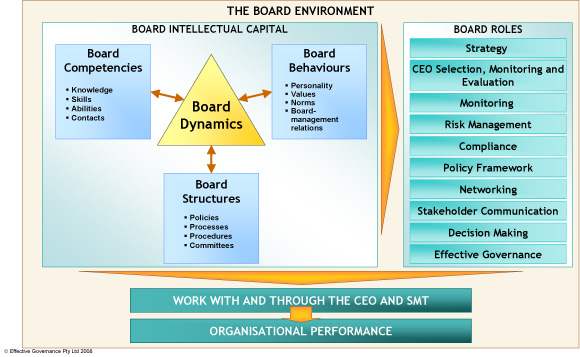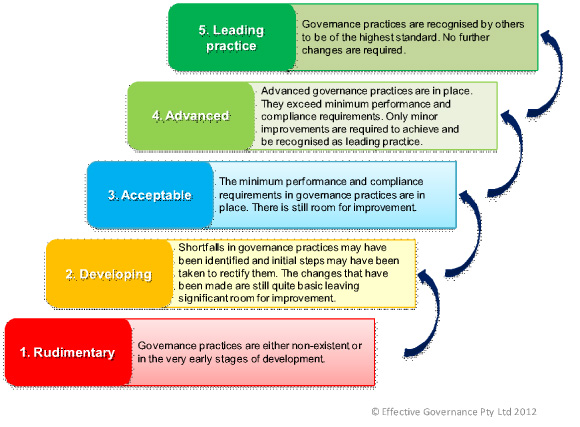governance
What Does Good Governance Look Like?
Published: May 7, 2012
Read Time: 7 minutes

The definition of Good Governance is akin to the definition of hard-core pornography offered by Justice Potter Stewart1 - we cannot define it, but we ‘know it when we see it’.
The high levels of governance and accountability required of both the private and public sectors in Australia are now being demanded in the not-for-profit (NFP) sector. While there does exist a view that governance standards in the NFP sector are not at the same standard as required in the commercial sector, this is far from the truth. In particular, there is a need for a high degree of accountability for NFP organisations in receipt of, and spending, donations from the public and/or government funding and to ensure that members’ money is protected for the long term.
An organisation’s governing body ‒ whether it is a board, committee or other body ‒ should be a strategic asset to an organisation whether it is focused on surplus or not; governance arrangements should be adding value to the organisation rather than draining often scarce resources.
To set the scene let’s consider what poor governance looks like. Poor governance might have the following attributes:
- A non-independent chair;
- Majority of the board of directors are not independent, have considerable conflicts of interest and are all old school chums;
- No CEO key performance indicators and no formal CEO annual review process;
- Board meetings that spend more time on operations than on strategic thinking and development;
- No agreement between the board and management on the organisation’s risk appetite;
- Non-ethical decision making;
- Bad media reports and dysfunctional board;
- Board review conducted by the chair as a one-on-one fire side chat;
- Poor or no surplus;
- Organisation extinction is regularly discussed.
Avoiding organisation extinction then is an imperative for boards. The Effective Governance High Performance Board Model (Figure 1) provides the framework for boards to reflect on their role and how that contributes to good governance. Both the board and the management team must be performing at a high level for a sustainable future to exist.

Board Reflection and Enhancement
In the past ten years, formal board reflection exercises (evaluations, reviews) have been increasingly used as a method of assessing the performance of boards of Australian organisations. The impetus for evaluating board performance can be attributed in part to increasing regulatory prescription. As a result, there has been rapid adoption of board evaluations in recent years by all listed companies and APRA-regulated entities, and the Australian Charities and Not-for-Profits Commission is expected to seek a similar outcome.
An equally compelling reason for boards to evaluate their performance is that all individuals and groups who focus on a purpose can benefit from feedback. Indeed, there is growing evidence that factors such as board working style, the ability of directors to work together and the competency of directors are not only just as important as structural factors relating to board performance, but are critical if boards are to function at a high level. Importantly, board evaluations allow the board to set the ‘tone from the top’ by sending a strong message to stakeholders that the board values a performance culture. This helps to explain why boards of non-listed companies, not-for-profit member and faith-based organisations have also embraced board evaluations. Properly conducted board evaluations help establish the individual and collective responsibilities of directors and identify where the board and individual directors need to enhance their performance.
The limits to existing board evaluation techniques
The traditional survey and interview techniques enable the board to assess its performance at any given point in time in terms of its roles such as strategy and planning, risk management, compliance, decision making and governance. They are also very useful in providing a snapshot of board competencies, structures and behaviours.
Such snapshots are undoubtedly useful in that they provide feedback to the board on areas of governance that require improvement. However, they do not take into account where the organisation sits in its lifecycle and what can reasonably be expected of it from a governance viewpoint given its level of maturity. Another problem with snapshots is that while they tell the board its current position, it can be difficult to tell in what direction the board should be heading. If there are a large number of areas where the board needs to improve, it can be overwhelming knowing where to start. Also, it can be difficult to benchmark a board’s performance objectively against other boards using the traditional tools for measuring board effectiveness. Surveys, for example, suffer from directors’ subjective biases and while comparisons can be made with other organisations using qualitative techniques, it is nevertheless challenging to do so in a holistic and structured way.
These observations raise an important issue in board evaluations: is it possible to benchmark boards? Firstly, the rating of these boards is a function of the level of insight of the directors – high scores do not necessarily represent high performance. Because of this insight, for boards to be benchmarked, directors would need to be common across the comparable boards. Secondly, board performance can be arrived at by different means and is contingent upon many factors including the organisation’s operating environment and industry – a point that is ignored where a score is simply contrasted with a sample of other scores.
The Board Maturity Model
From our experience at Effective Governance, having reviewed over 350 boards, we have identified the need for a practical approach that allows boards to compare their performance with boards at a similar stage of maturity and that provides a road map to good governance. A maturity model offers such an approach.
A maturity model is a two-dimensional structured approach for describing the principal characteristics of an organisation or a project at various stages of maturity. One of the earliest maturity models is Philip Crosby’s Quality Management Maturity Grid.
A powerful feature of such models is that it is quite easy to assess an organisation’s current level of performance by matching it with one of the typical behaviours in a grid. An equally powerful feature is that it is very easy to see what the organisation needs to do next on the pathway to good governance. It also allows an organisation to benchmark its level of maturity against other organisations because those making the assessments have a common understanding of what constitutes a particular level of performance against each measurement category.
The Effective Governance Board Maturity Model draws its inspiration from Philip Crosby’s Quality Management Maturity Grid2.
The two dimensions of the Board Maturity Model
The first dimension of the Board Maturity Model consists of a number of stages ranging from an initial baseline stage progressing through to an optimal stage where leading practices are followed or established. Progressing from one stage to the next is a little like obtaining different coloured belts in the martial arts, in that each stage builds upon and incorporates the requirements of the preceding stages. In the case of board governance, the stages are depicted in Figure 2.

The second dimension of a maturity model consists of the key areas that must be addressed within each stage before the organisation can move to the next stage. At Effective Governance, we use our High Performance Board Model (See Figure 1), developed by our colleague Emeritus Professor Geoffrey Kiel and Associate Professor Gavin Nicholson, as the framework for determining the key areas that must be evaluated to move from one stage to the next. The organisational environment component of the High Performance Board Model takes into account where the organisation sits in its life cycle and what can be expected of the organisation at any given stage of maturity.
The 14 key areas for evaluation are drawn from the board environment in Figure 1 and are: board roles; strategy; CEO selection; monitoring and evaluation; monitoring; risk management; compliance; policy framework; networking; stakeholder communication; decision making; effective governance; board competencies; board behaviours and board structures.
Pathways to good governance
By implementing the Effective Governance Board Maturity Model, a board can decide, given their organisational environment, which level of maturity is sufficient for their context. Having established the maturity level, the board is provided with the stepping stones or incremental governance initiatives on the pathway to good governance.
Share this Article
Recommended Reading
Recommended Viewing
Author
-
Ex-Managing Director
Effective Governance
- About
-
At the time of writing James was Managing Director of Effective Governance, an advisory firm that provides expertise and assistance on corporate governance, strategy and risk in Australia and New Zealand to a wide variety of clients including public and private companies, not-for-profit organisations, associations, co-operatives and government owned corporations.
Found this article useful or informative?
Join 5,000+ not-for-profit & for-purpose directors receiving the latest insights on governance and leadership.
Receive a free e-book on improving your board decisions when you subscribe.
Unsubscribe anytime. We care about your privacy - read our Privacy Policy .







